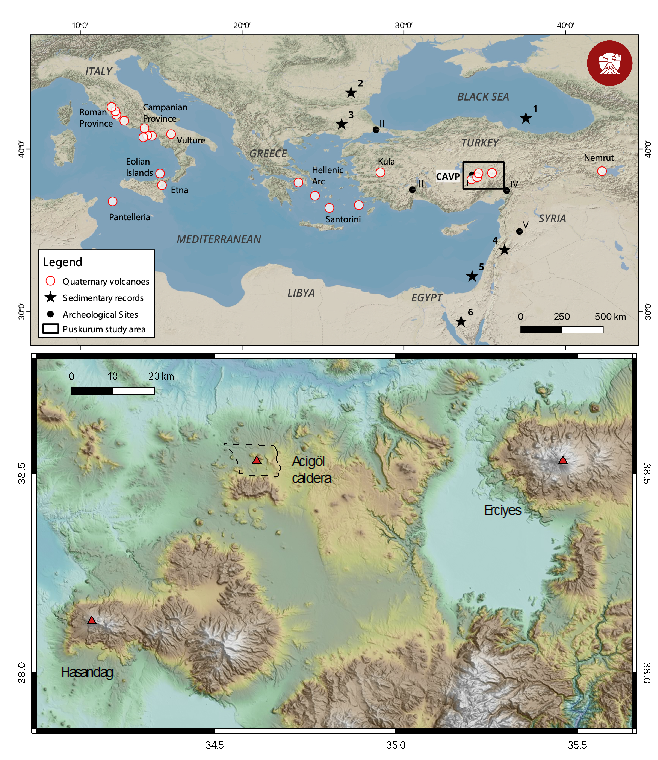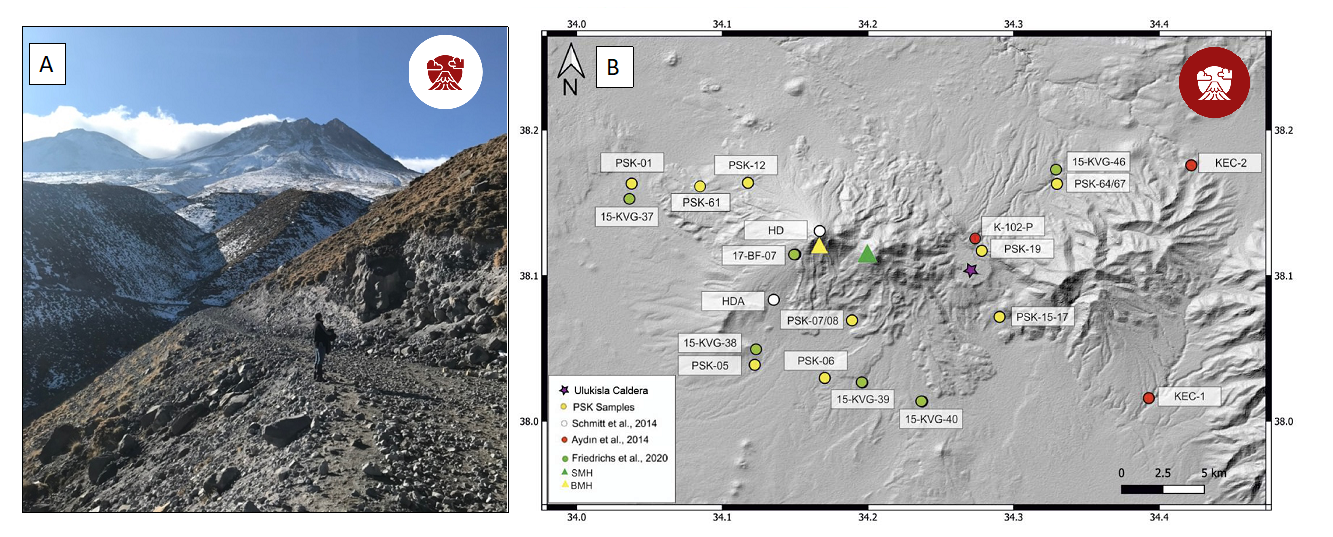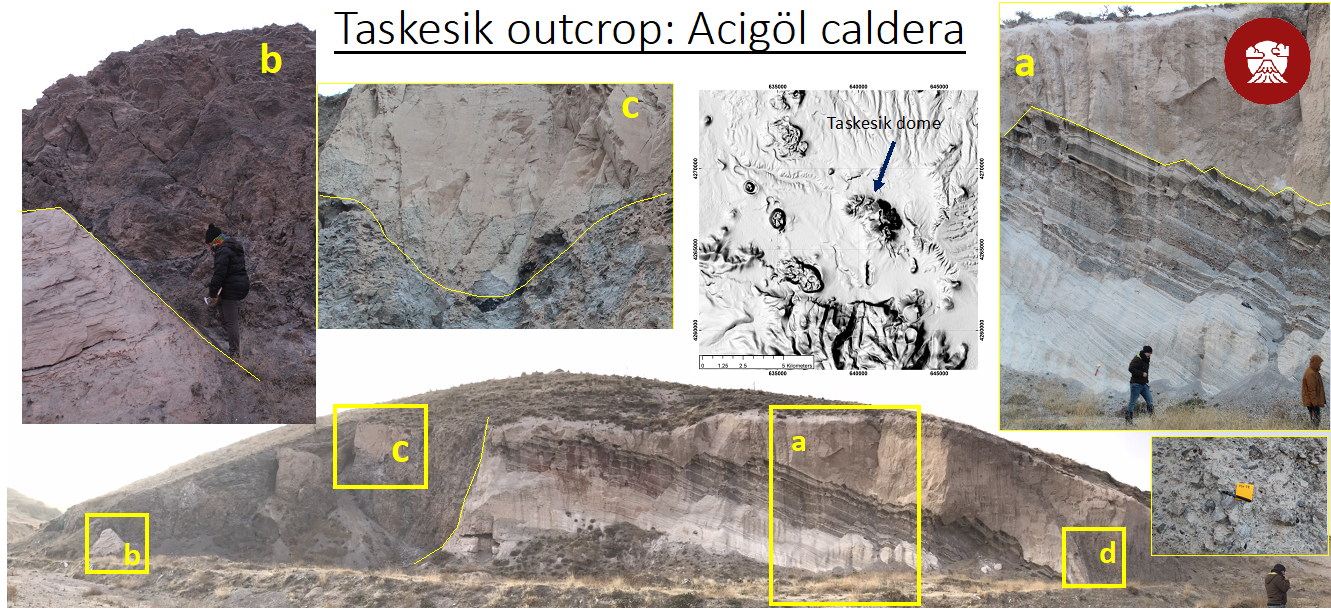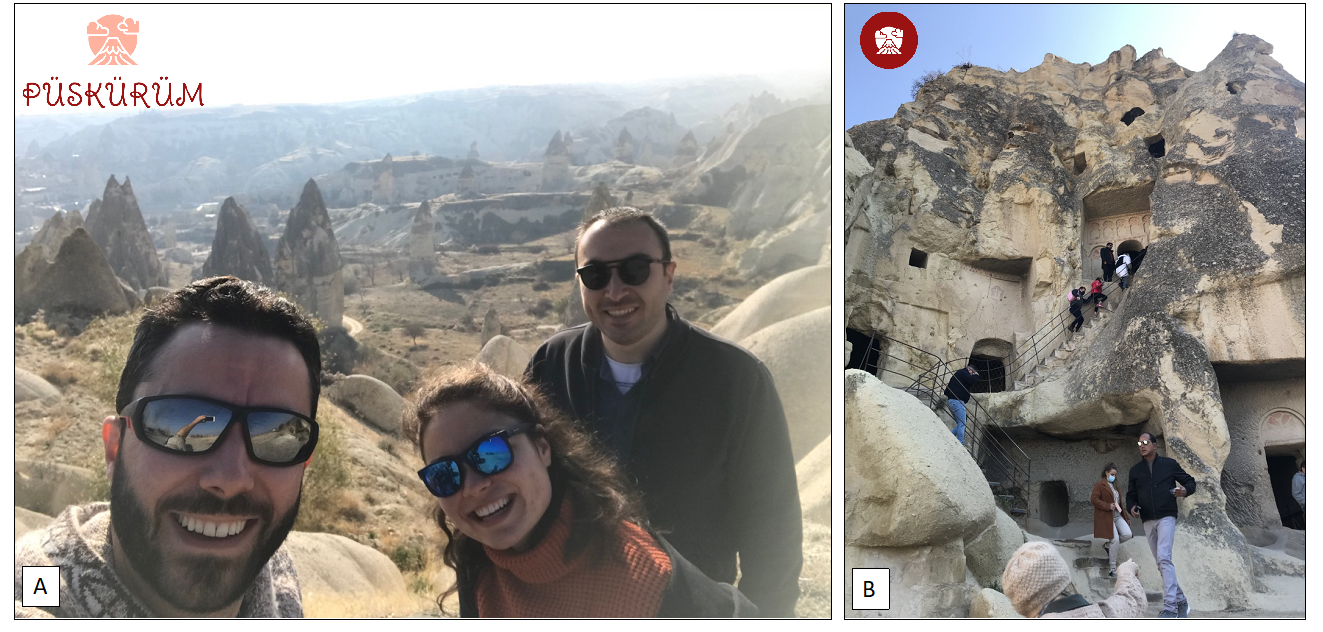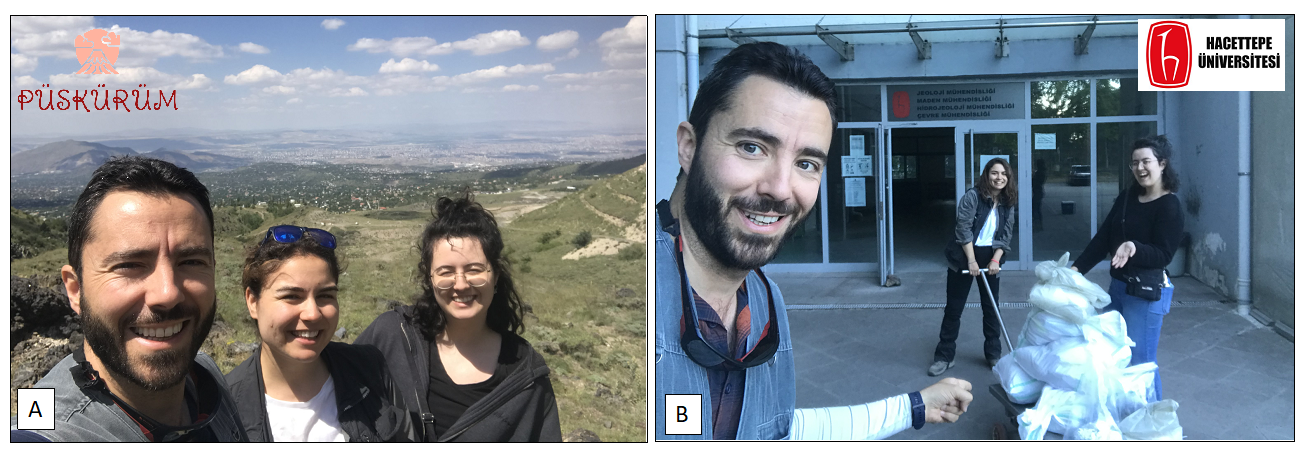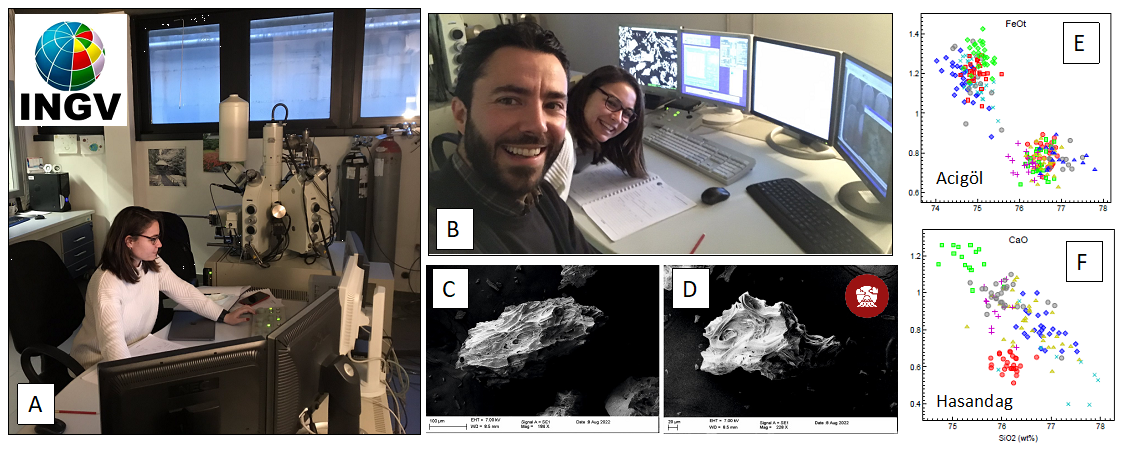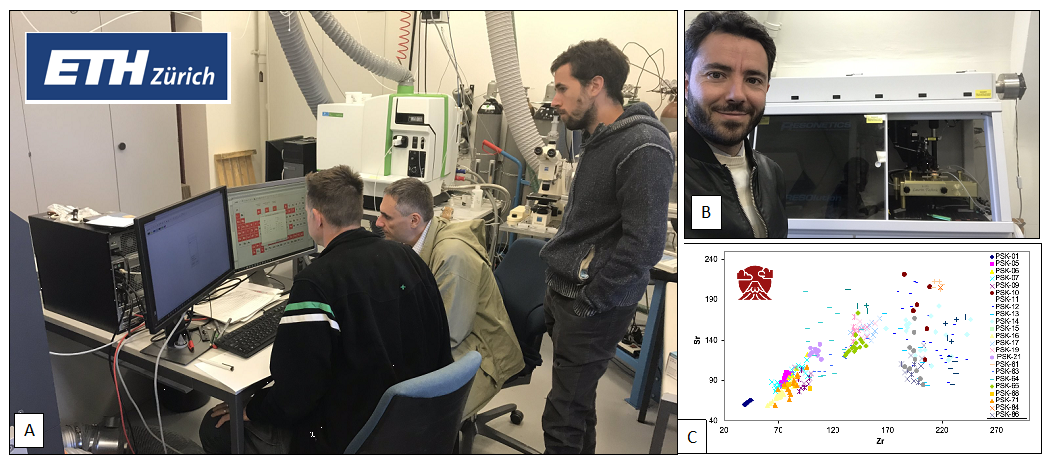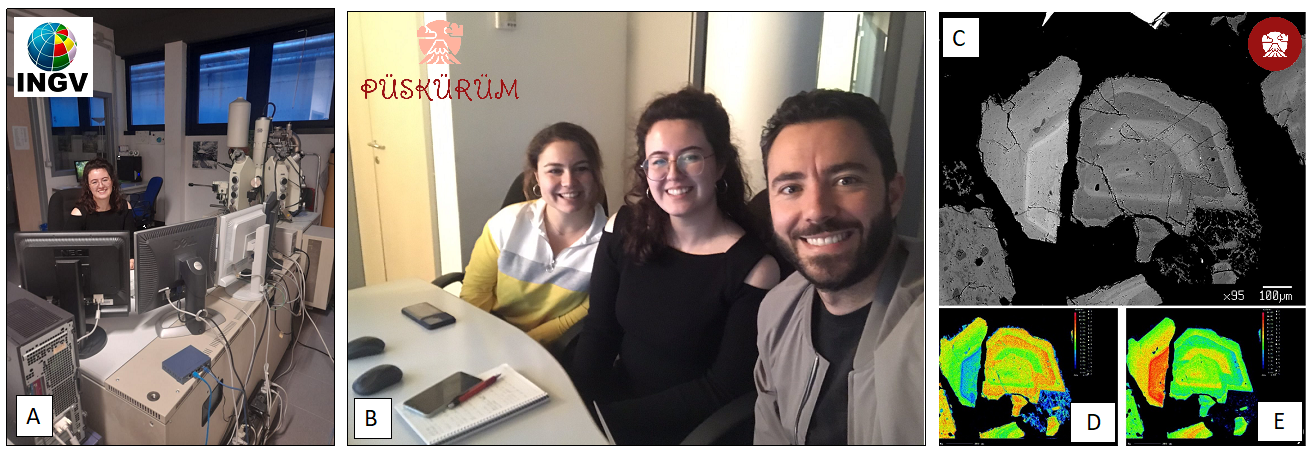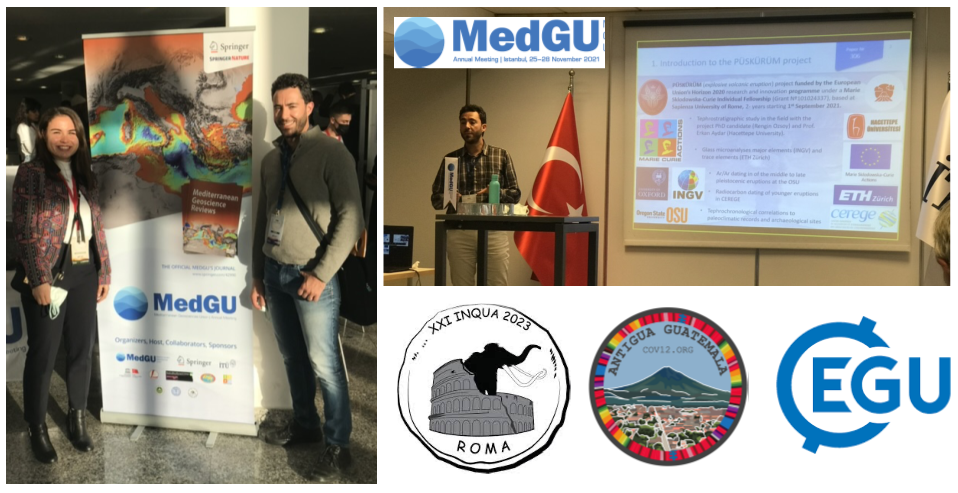PÜSKÜRÜM - Characterisation of the late Pleistocene pyroclastic deposits in Central Anatolia to reconstruct the recent explosive volcanic history, synchronise sedimentary records, and better assess volcanic hazards in Turkey

The aim of PÜSKÜRÜM project, which is based in the Department of Earth Sciences at La Sapienza – University of Rome (Italy), is to differentiate and characterize the pyroclastic deposits produced by explosive eruptions from Açigöl caldera, Hasandağ, and Erciyes stratovolcanoes (including mapping, stratigraphic logging, chemical analyses, and dating), which are the most active and largest volcanoes of the Central Anatolian Volcanic Province (CAVP, Turkey; Fig. 1). This study is necessary to reconstruct the explosive volcanic history of the CAVP during the middle Pleistocene – Holocene, and therefore, to better assess the current volcanic hazards posed by these volcanoes on the region. But also, PÜSKÜRÜM results will help to complete the gap in the tephrostratigraphic framework of the easternmost part of Europe and to allow the synchronization of sedimentary records by distal tephra correlations (including paleoenvironmental and paleoclimatic registers, and/or archeologic sites).
- Introduction to PÜSKÜRÜM project and state-of-the-art
Explosive volcanic eruptions emit violently fragmented pyroclastic material into the atmosphere that deposit ash layers (tephra) over extensive areas, which can affect large populations and the environment. At the same time, these tephra layers constitute chronostratigraphic markers (or isochrones) in a huge variety of sedimentary records (including paleoclimatic and archaeological sequences), so their correlation becomes crucial for synchronizing registers and for establishing how past explosive eruptions have affected a region and its occupants. Since the fine ash can be dispersed over thousands of kilometres, the only way to correlate tephra is by using the chemical composition of the volcanic glass.
Despite an increasing number of recent studies identified many fine volcanic ash layers that are thought to be from large eruptions produced by active volcanoes of the Central Anatolian Volcanic Province -CAVP (e.g. in cores from the Black Sea, Eastern Mediterranean Sea, caves in Egypt, or several small Romanian lakes), little is known about the spatial and temporal scale of explosive volcanism in Turkey. Such tephrochronologic studies are important to improve our understanding of the Anatolian volcanism and to more accurately constrain the hazards that the active volcanoes of CAVP pose to the often-large populations surrounding them (e.g. the 1.3 million people of Kayseri city).
The aim of the PÜSKÜRÜM project is to identify and characterize the proximal pyroclastic deposits of the Açigöl caldera, Hasandağ and Erciyes stratovolcanoes (mapping, logging and sampling), in order to reconstruct the tephrostratigraphic framework (i.e., EMP and LA-ICP-MS chemical glass data) and the explosive volcanic history of the CAVP during the late Pleistocene – Holocene (including geochronological studies by C14, U-Th and Ar/Ar), for forthcoming correlations of large pyroclastic deposits to tephra layers deposited in distal records.
Therefore, the eruption volumes and magnitudes will be better estimated, and impacts of potential future eruptions able to asses. Here we present the preliminary results of the first fieldwork campaign around the most active and dangerous volcanoes of the CAVP.
|
Fig. 1: A) Location of the main volcanoes in the Mediterranean region that have been active during the Quaternary (white circles), and the archaeological sites (black circles) and sedimentary records (black stars) where have been found tephra potentially from the Central Anatolian Volcanic Province (CAVP). B) Map of the PUSKURUM project study area with the 3 main composite volcanoes within the CAVP. 1: Black sea, 2: Romanian lakes, 3: Phillipon basin, 4: Yammouneh basin, 6: Sodmein cave. I: Kaletepe Deresi 3, II: Yamburgaz Cave, III: Karain Cave, IV: Dursunlu, V: Latamne. |
- Fieldwork
Although recent studies have characterized some proximal deposits around the main volcanoes of CAVP, they mostly focussed on effusive products (such as lava flows and domes). Therefore, fieldwork in this region is needed to identify, log, sample and map the distribution of the still undifferentiated pyroclastic deposits produced by the largest and recent explosive eruptions. At the moment, the PÜSKÜRÜM team have carried out two fieldwork campaigns within in the Central Anatolian Volcanic Province and around Hasandağ and Erciyes stratovolcanoes (Fig. 2 and 5), Acigöl caldera (Fig. 3), and Cappadocian Ignimbrites (Fig. 4). The first campaign was done in November 2021 by: 1) Dr. Ivan Sunyé Puchol, the Marie-Curie Fellow awarded with the PÜSKÜRÜM grant and Principal Investigator of project; 2) MSc. Rengin Özsoy, the PhD student of the PÜSKÜRÜM project who is focused on the reconstruction of the Hasandağ volcanic history (Rengin is based in the Department of Earth Sciences of La Sapienza – University of Rome, and supervised by Dr. Ivan Sunyé Puchol and Prof. Silvio Mollo, the scientific in charge of the PÜSKÜRÜM project at La Sapienza); and 3) Dr. Efe Akkas, one of the PÜSKÜRÜM’s collaborators from Hacettepe University, Ankara (Turkey).
|
|
|
Fig. 2: a) Photo of the summit area of Hasandağ stratovolcano (two peaks), the youngest and most active (increasing of fumaroles and seismicity activity) of the Central Anatolian Volcanic Province (CAVP), with at least 3 caldera collapses (Aydar and Gourgaud, 1998), and several Block-and-ash flows (Friedrichs et al., 2020). b) This map shows the study area and the location of the observed exposures around Hasandağ (yellow dots are the outcrops sampled in this study). Note how close to the recent lava fronts are many of the surrounding towns (black dots), which have been built above the Hasandağ pyroclastic deposits investigated in this project (including large ignimbrites, but also on smaller BaF deposits). BMH= Big Mount Hasan, SMH= Small Mount Hasan.
|
|
|
|
Fig. 3: The tephra layers from Taskesik tuff cone (inner part of Acigöl caldera, see map) are faulted (a) by the uplift during emplacement of the Taskesik obsidian dome (b). The first PDCs of the pinky UAT ignimbrite are deposited continuously atop of the Taskesik tuff cone deposits (a) without any paleosoil neither hiatus of time between these two deposits (coetaneous eruptions), and also cut by the faults. However, the last PDCs of the uppermost part of UAT pinky ignimbrite is deposited on top pf the obsidian Taskesik dike/dome (c). This tephrostratigraphic relationships indicates that the pinky UAT ignimbrite was emplaced just after the Taskesik tuff cone, and that the Taskesik dome was emplaced during the deposition of the pinky UAT ignimbrite (only partially cut by the dike). d) Detail of coignimbritic lag breccia thicker at the food of the tuff cone.
|
|
|
|
Fig. 4: a) panoramic view of the famous fairy chimneys along the Cappadocian Ignimbrites (from left to right: Ivan Sunyé Puchol, Rengin Özsoy and Efe Akkas), where Phrygians (old Anatolian civilization) have carved houses since the XIII century BCE, and b) later the Christians (Byzantine Roman people) used as churches. |
The second fieldwork campaign was carried out in June 2022 and for then, the PÜSKÜRÜM project had incorporated a new team member: the BSc. Simge Kaya, a master student focused on the petrological study of Erciyes stratovolcano products, who is based at the Hacettepe University and supervised by Prof. Erkan Aydar (the main Turkish collaborator of the PÜSKÜRÜM project) and Dr. Ivan Sunyé Puchol.
|
|
|
Fig. 5: a) Panoramic view of the Kayseri city (> 1 M people) from the summit northern flank of Erciyes stratovolcano (from left to right: Ivan Sunyé Puchol, Rengin Özsoy and Simge Kaya) and b) a trolley full of samples collected during the second fieldwork (Department of Geology, Hacettepe University, Ankara). |
- Laboratory work
- Geochemistry (major and trace elements on glass and crystals):
Samples for glass geochemical analyses were prepared at the Istituto Nazionale di Geofisica e Vulcanologia (INGV) – Rome since January 2022. Pumices and ashes sampled in the field were cleaned, crushed, washed, sieved, dried, and mounted in epoxy resin by MSc. Rengin Özsoy and supervised by Dr. Ivan Sunyé Puchol, and Dr. Manuela Nazzari (INGV researcher). Mounts were polished and carbon-coated before major elements analyses with the JEOL JXA-8200 electron microprobe (EMP) equipped with five wavelength-dispersive spectrometers (Fig. 6).
|
|
|
Fig. 6: a) Rengin Özsoy performing the glass microanalyses by the EMP at INGV and b) reducing the data together with Dr. Ivan Sunyé Puchol (March 2022); c) and d) two backscattered images of volcanic ashes for morphological description, and e) and f) two bi-plot diagrams showing some major oxides concentration (i.e. SiO2 vs FeO and CaO) from Acigöl and Hasandağ volcanic glass. |
The same samples were used to analyse the glass trace element concentrations at the Eidgenössische Technische Hochschule (ETH) in Zürich (Switzerland) by means of a Laser Ablation -Inductively Coupled Plasma - Mass Spectrometry (LA-ICP-MS; Fig. 7). Both, major and trace element measured on glass shards, will be used first to characterise the pyroclastic deposits and find the volcanic source, but later to complete the tephrostratigraphic framework of the CAVP (new stratigraphy and chemical database) and to do tephrochronologic correlations by fingerprint to distal sedimentary records (i.e. paleoclimatic registers and/or archaeologic sites).
|
|
|
Fig. 7: a) Prof. Silvio Mollo (Sapienza University) calibrating the instrument together with Dr. Marcel Guillong (ETH researcher) and Dr. Alessio Pontesilli (INGV-Rome researcher); b) Dr. Ivan Sunyé Puchol showing the Laser (May 2022); c) bi-plot diagram showing the concentration of Sr vs Zr of several PUSKURUM glass samples. |
Petrological and geochemical analyses on minerals from Erciyes stratovolcano (including plagioclase, hornblende, biotite and Fe-Ti oxides) were performed at INGV-Rome by BSc. Simge Kaya and MSc. Rengin Özsoy and supervised by Dr. Ivan Sunyé Puchol (Fig. 8) and Dr. Manuela Nazzari. This petrogenetic data is important to study the plumbing system beneath Erciyes volcano and the crystallization conditions of three pyroclastic deposits (Karagüllü, Perikartin and Dikkartin), which can be erupted altogether during a common explosive eruption ~9 ka ago (Holocene). The chemistry of mineral phases helps to complement the characterization of pyroclastic deposits and more robustly correlate eruptions. Moreover, core-to-rim compositional zonation in clinopyroxenes, hornblende and plagioclases represent a valuable tool for recording each specific parameter of magma and petrogenetic processes occurred before every single eruption, even within the same magmatic reservoir.
|
|
|
|
Fig. 8: a) Bsc. Simge Kaya analysing the Erciyes minerals by EMP at INGV-Rome (October 2022), to b) later reduce the data with MSc. Rengin Özsoy and Dr. Ivan Sunyé Puchol; c) example of a zoned plagioclase phenocryst and compositional maps of d) Na2O and e) CaO. |
b. Geochronology (14C, 234U/ 230Th and 40Ar/39Ar):
Identify deposits erupted by the Central Anatolian volcanoes (e.g. Acigöl, Hasandağ and Erciyes) in distal records may help to constrain the time of eruptions as these often have detailed age-models. For eruptions of unknown age, radiometric-dating methods will be employed by PUSKURUM collaborators in order to obtain an accurate and precise chronology. Radiocarbon analyses in paleosoils developed on pyroclastic deposits younger than 45 ka (the upper limit of the 14C method) will be carried out at CEREGE (Aix-Marseille University, France) by Dr. Thibaut Devièse (Fig. 9a). Late Pleistocene eruptions will be dated using 234U/ 230Th in zircons (eruptions between 45 and 300 ka, limits of this chronological method) at the ETH-Zurich (Switzerland) by Dr. Lorenzo Tavazzani. Middle Pleistocene eruptions (older than 300ka) will be dated using the 40Ar/39Ar method in K-bearing minerals at the Argon Geochronology Laboratory of the Oregon State University (USA) by Dr. Dan Miggins, and at the SUERC facilities of the Glasgow University (UK) by Dr. Dan Barford (Fig. 9b).
|
|
|
Fig. 9: a) Drs. Thibaut Devièse and Ivan Sunyé Puchol at the Radiocarbon lab (accelerator mass spectrometer - AMS) of the CEREGE (Aix-Marseille University, France); and b) Dr. Dan Barford at the 40Ar/39Ar lab in SUERC (Glasgow, UK) using the new ARGUS VI instrument. |
- Dissemination of the PÜSKÜRÜM project in Scientific Conferences
PÜSKÜRÜM project has been presented at the 1st Mediterranean Geoscience Union (MedGU) Conference held in Istanbul on November 2021 (Fig. 10). The Phd student Rengin Ozsoy and Dr. Ivan Sunyé Puchol (PI of the project) had introduced PÜSKÜRÜM to the national and international community in Turkey, getting valuable feedback and potential collaborations. The rationale and initial results of the PÜSKÜRÜM project will also be presented in the XXI International Union for Quaternary Research (INQUA) congress that will be held in La Sapienza University of Rome (Italy) on July 2023. In that occasion, Simge Kaya will present the results of her master thesis about the petrogenetic study on Erciyes volcano, Rengin Özsoy the advances of her PhD thesis on the Hasandağ volcanic history reconstruction, and Dr. Ivan Sunyé Puchol the geologic evolution of the Acigöl caldera collapse. During this conference, the PÜSKÜRÜM team will offer a Workshop on the “Recent explosive volcanism of Turkey and related hazards”. More international participation in Scientific Assemblies to present the novel results from the PÜSKÜRÜM research are programmed. For example, the XII Cities on Volcanoes (COV-12) that will be held in Antigua (Guatemala) on February 2024, and the European Geosciences Union (EGU) on April 2024.
|
|
|
Fig. 10: Images showing the participation of Rengin Özsoy and Ivan Sunyé Puchol at the 1st MedGU (Istanbul 2021) and logos of the future conferences where the PÜSKÜRÜM team will present the research results (INQUA, COV-12 and EGU). |
- Seminars, workshops and outreach activities
In order to maximize public engagements, the PÜSKÜRÜM project and its results will be promoted to general public, creating awareness of the performed research beyond the scientific community. Dr. Ivan Sunyé Puchol (the PI of the project) has organized and participate in several seminars open to students, researchers and public in general in La Sapienza (Fig. 11 a) and Hacettepe University (Ankara, Turkey), in CIVIS short-courses on geochronology (Fig.11 b), and workshops of Sapienza Info-Days (Fig. 11 d). Moreover, he is collaborating once per two-weeks with RAB radio (Fig.11 c) talking about natural environment, energy transition, ecology and also about volcanology and the PÜSKÜRÜM project. More outreach activities are programmed, as the Researchers’ Night (#MSCAnight) that takes place every September in Rome and simultaneously in many cities all over Europe. PÜSKÜRÜM has also internet presence on its project webpage (coming soon), a YouTube-channel and other profiles in social media such as Twitter.
|
|
|
Fig. 11: seminars in a) the Department of Earth Sciences of La Sapienza (Rome, Italy) and b) CEREGE (Aix-Marseille University, France); c) logo of RAB radio and d) program of the Sapienza Info-Days workshop (where Dr. Ivan Sunyé Puchol have presented the PÜSKÜRÜM project and give hints and tips to potential MSCA-Fellowship applicants. |


